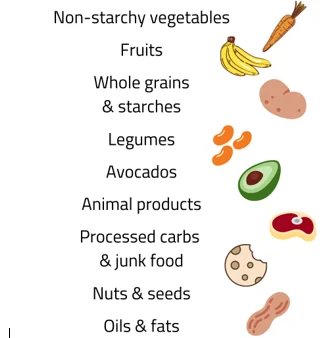Blog
What is Calorie Density
By Kenda Hettinger a Recent ASU Nutrition Student
When I first had my daughter in 2014, I kept 30 pounds of my excess weight for about a year. Then I stumbled across an article on calorie density and started to make small changes to my diet. The excess weight slipped off and I began to feel really good.
Learning about calorie density shouldn’t only be for those looking to lose weight. Most of the low-calorie dense foods are the most nutritious and fiber-filled foods you could eat. A meta-analysis completed in 2018 suggests that higher intake of fiber could help protect you against cardiovascular disease, type 2 diabetes, and pancreatic cancer.
What is calorie density?
The calorie density of a food is the measure of how many calories are in a given weight or volume of food. One hundred grams of spinach contains 24 calories and tons of vitamins, minerals, and fiber. One hundred grams of McDonald’s french fries contain 323 calories and lots of saturated fat. Which one is better? By the way, 100 grams of spinach is about 5 cups and 100 grams of McDonald’s french fries is less than their medium serving.

Benefits of eating low-calorie density.
When you eat at a low-calorie density, you tend to:
- Eat less processed foods
- Eat leaner meats
- Consume more vitamins and minerals
- Reduce your calorie intake
How to eat with calorie density in mind.
- Eat when you are hungry and eat until comfortably full.
- When eating, start with a low-calorie food such as soup or salad.
- Avoid high-calorie drinks, these do not fill you up.
- Oil is the highest in calories, watch out for hidden oil in your food.
- When making your plate, fill it mostly with vegetables and fruits and accessorize with the higher calorie-dense foods.
- Avoid high fat condiments.
- Some fats, such as avocados, seeds, and nuts are healthy and your body needs these but they should still be consumed in moderation.
The following illustration lists different food categories in order of least calorie-dense to most calorie-dense. There is some overlap of the different food categories, but it is trivial. In general, you should eat mostly towards the top and much less towards the bottom.
In conclusion
Eating with calorie density in mind is an easy way to control weight and eat a healthful diet. There is no calorie counting or restriction of the low-calorie foods.
Resources
Veronese, N., Solmi, M., Caruso, M., Giannelli, G., Osella, A., Evangelou, E., Tzoulaki, I. (2018). Dietary fiber and health outcomes: An umbrella review of systematic reviews and meta-analyses. The American Journal of Clinical Nutrition, 107(3), 436-444.
















